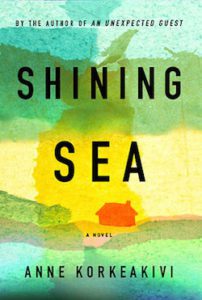
Anne Korkeakivi’s first novel, An Unexpected Guest, relied in part on Virginia Woolf’s dinner-party setup from Mrs. Dalloway. Given this lineage, it seems reasonable to assume that the author is aware, as her literary ancestor certainly was, of the pitfalls of being labeled a “woman” writer. Woolf was famously wary of that designation; in her diaries and letters she worried that her work would be viewed as “sentimental” (a code for “feminine” if I ever heard one). To ward against this possibility, Woolf made sure novels like Mrs. Dalloway weren’t merely about dinner parties; there were politics and war and suicidal ex-soldiers too. Likewise To the Lighthouse is not just about marriage; perception, art, death, and the menace of time are the “serious” subjects that help Woolf attain her status as the exception to the supposed rule that writing by women is frivolous while men’s stories are meaningful and important. If Korkeakivi’s new novel, Shining Sea, is less straightforwardly Woolfian than its predecessor, a desire to avoid the “woman’s writing” label is one way it may fit that description.
Shining Sea opens in 1962 with the voice of Michael Gannon—a respected doctor, adored husband, and loving father of four. Right away we are introduced to one of the book’s major themes—the influence of the past upon the present. Michael’s three years as a POW in WWII finally catch up with him; he dies from heart failure on his back porch, in front of his young children and pregnant wife, Barbara.
We pick up two days later, on Easter Sunday, with Barbara, whose insistence on wearing a yellow dress to her husband’s funeral (he was repainting their house yellow when he died; she wore yellow the day they met in an army hospital) is out of keeping with her normally pragmatic temperament. We see this in the way she handles herself following her husband’s death; the eggs that were to have been dyed will now be deviled and served alongside Easter ham sandwiches for the after-funeral crowd. She will not allow herself to sit down and weep: the children must be cared for; the baby has to get born.
While Barbara works quietly but efficiently to keep herself and her family together, her youngest son, Francis, disappears, prompting the police to return him reluctantly to his home. He will continue to run away for most of his life. The next chapter is in Francis’s voice, three years later, and the rest of the novel alternates, more or less regularly, between Barbara and Francis. Intervals start out relatively short—three years, two years—but by the end we’re skipping ahead by ten years, then nearly thirty. Perhaps that’s what life is like, too: you see your family all the time when you’re young but then you grow up, move away, grow apart, and the spaces between you widen. That is certainly the case with Barbara and Francis.
Perhaps this theme of the compression and expansion of distance is one reason why Korkeakivi chose these two characters as her protagonists. As the matriarch of the brood, Barbara seems an obvious enough choice, but since she has five children, I found myself repeatedly wondering why Francis gets to be the youth representative. In some ways he is a good foil to Barbara—her practical resolution balances out his flighty romanticism. She stays in LA after her husband’s death, until a reasonable and almost businesslike second marriage (to a man who is kind and generous, though clearly gay) takes her to Phoenix. Francis, meanwhile, can’t seem to stay in one place. We see him running wild as a child in and around LA, as a teenager at Woodstock, and then as a young man tramping around Europe.
Patty Ann is the child who crops up in her mother’s thoughts most often. Barbara is obsessed by the belief that Patty Ann has wasted her potential by not going to college (preferably an East Coast one like Vassar, where her aunt teaches) and instead marrying her drug-dealing high school boyfriend to help him avoid the Vietnam draft. In those days, marriage may not have precluded Patty Ann from the education her mother desired, but her immediate pregnancy, followed rapidly by a second, does. (Upon learning of the second child Barbara suggests Patty Ann look into recently legalized birth control options). Patty Ann’s first marriage crumbles, a second is worse, but a third finally proves the charm.
While Patty Ann remains in LA, Francis travels across the US and Europe, providing the author opportunities for evocative descriptions of sex in VW vans in rural New England, escapades with posh drunks in London, and the sweeping green vistas and cold, dark seas of Ireland and Scotland. And yet, because he doesn’t allow anyone close emotionally, including the reader, I sometimes found Francis’s parts a bit boring. Running away leaves him empty, and the reader also experiences this barren mood in his sections of the novel. Perhaps because she doesn’t really know him, his mother’s inner monologue is more often concerned with her daughter, and I would have liked the chance to see Patty Ann’s life from inside.
To me, having two female main characters—even those whose lives are circumscribed by their homes and families—would not have made the book any less deep or important. In fact, it might have had the opposite effect. Luckily for all of us, what is considered worthwhile literary subject matter is changing (albeit slowly), and a book dealing complexly with a young woman’s feelings about missing out on college, being in an abusive relationship, and giving up a child for adoption would no doubt garner more respect today than it would have in, say, Virginia Woolf’s time. Not getting that close-up view of Patty Ann’s decisions feels like a too-careful choice by the author, and a loss for the reader.
Overall, Shining Sea has an impressive scope, engaging prose, and compelling themes. I would have been willing to forgo some of the glittering surface, however, for more of the messy, murky depths.





